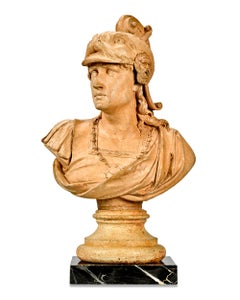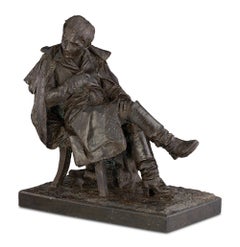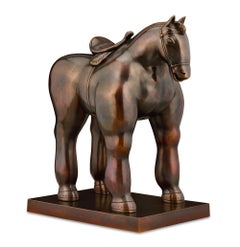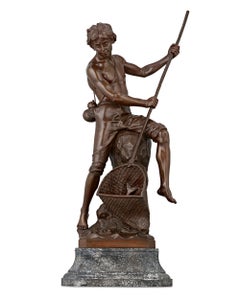Want more images or videos?
Request additional images or videos from the seller
1 of 8
Friedrich GoldscheiderNapoléon as General Bust1845-1900
1845-1900
$24,500List Price
About the Item
- Creator:Friedrich Goldscheider (1845 - 1897)
- Creation Year:1845-1900
- Dimensions:Height: 23 in (58.42 cm)Width: 14 in (35.56 cm)Depth: 9 in (22.86 cm)
- Medium:
- Period:
- Condition:
- Gallery Location:New Orleans, LA
- Reference Number:Seller: 31-06961stDibs: LU1866107772
About the Seller
5.0
Vetted Professional Seller
Every seller passes strict standards for authenticity and reliability
Established in 1912
1stDibs seller since 2013
19 sales on 1stDibs
Typical response time: 10 hours
Authenticity Guarantee
In the unlikely event there’s an issue with an item’s authenticity, contact us within 1 year for a full refund. DetailsMoney-Back Guarantee
If your item is not as described, is damaged in transit, or does not arrive, contact us within 7 days for a full refund. Details24-Hour Cancellation
You have a 24-hour grace period in which to reconsider your purchase, with no questions asked.Vetted Professional Sellers
Our world-class sellers must adhere to strict standards for service and quality, maintaining the integrity of our listings.Price-Match Guarantee
If you find that a seller listed the same item for a lower price elsewhere, we’ll match it.Trusted Global Delivery
Our best-in-class carrier network provides specialized shipping options worldwide, including custom delivery.You May Also Like
Antique Italian sculptor - 18/19th century terracotta sculpture - Memento Mori
Located in Varmo, IT
Terracotta sculpture - Memento mori. Italy, 18th-19th century.
16 x 25 x h 18 cm.
Entirely in terracotta.
- This item is sold with a certificate of authenticity with legal validi...
Category
Late 18th Century Old Masters Figurative Sculptures
Materials
Terracotta
$2,393
H 7.09 in W 6.3 in D 9.85 in
Nok Culture
Located in Wien, Wien
Nok culture
Sitting
500 B.C. - 200 A.D.
Terracotta
Height 60 cm
TL expert opinion of the University of Vienna
Prof. Dr. Rudolf Erlach
Provenance:
Private collection Nice
Category
15th Century and Earlier Figurative Sculptures
Materials
Terracotta
Roman 18th century terracotta model for the sculpture of San Camillo de Lellis
Located in London, GB
This remarkably fluid terracotta bozetto was made in preparation for Pietro Pacilli’s most important public commission, a large-scale marble statue of San Camillo de Lellis for the nave of St Peter’s Basilica in Rome. Expressively modelled, this terracotta sculpture is a rare and significant work made by a major Roman sculptor at a transformative moment of European sculpture. Pacilli began his working life on the great Baroque decorative projects initiated in the seventeenth century, but he found success as a restorer of ancient sculpture working to finish antiquities for a tourist market, becoming an important figure in the emergence of an archaeologically minded Neoclassicism. Pacilli trained Vincenzo Pacetti and provided important decorative work for the Museo Pio-Clementino, at the same time he is recorded restoring some of the most celebrated antiquities excavated and exported during the period.
Pacilli was born into a family of Roman craftsmen, his father Carlo was a wood carver, and Pacilli is recorded working with him on the Corsini Chapel in San Giovanni Laternao as early as 1735. In 1738 his terracotta model of Joseph and Potiphar’s Wife won the first prize in the second class of the sculpture concorso at the Accademia di San Luca, this is particularly notable as Bartolomeo Cavaceppi came third. He worked as a carver and stuccoist completing works for the churches of San Marco and SS. Trinita dei Domeniciani Spagnoli. Pacilli operated as a sculptor and restorer of antiquities from his studio at the top of the Spanish Steps, close to Santa Trinita dei Monti, where he is listed as a potential vendor to the Museo Pio-Clementino in 1770.
In 1763 Pacilli completed a silver figure of San Venanzio for the treasury of San Venanzio. He is recorded as Pacetti’s first master and it was evidently through Pacilli that he began to acquire his facility as a restorer of ancient sculpture. Pacilli, at his studio ‘poco prima dell’Arco della Regina alla Trinita dei Monti,’ exercised, what the nineteenth-century scholar, Adolf Michaelis called ‘rejuvenating arts’ on several important pieces of classical sculpture, including in 1760 the group of a Satyr with a Flute for the natural brother of George III, General Wallmoden, Hanovarian minister at Vienna. In 1765, Dallaway and Michaelis record that Pacilli was responsible for the restorations, including the addition of a new head, to the Barberini Venus which he had acquired from Gavin Hamilton. The Venus was then sold to Thomas Jenkins, who in turn passed it on to William Weddell at Newby Hall. In 1767 Pacilli exported a series of ancient busts ‘al naturale’ including portraits of Antinous, Julius Ceaser and Marus Aurelius, also a statue of a Muse and a Venus. As early as 1756 Pacilli seems to have been operating as an antiquarian, helping to disperse the collection of the Villa Borrioni. Pacilli supplied sculpture to notable British collectors, including Charles Townley, who on his first trip to Italy purchased the Palazzo Giustiniani statue of Hecate from Pacilli. Pacilli was involved with the Museo Pio Clementino from its conception, supplying busts of Julius Ceaser and a Roman Woman as well as completing stucco putti surmounting the arms of Pope Bendedict XIV to signal the entrance to the new Museo Critiano.
In 1750 Il Diario Ordinario del Chracas announced that Pacilli had begun work on a sculpture of San Camillo de Lellis for St Peter’s. Camillo de Lellis founded his congregation, the Camillians, with their distinctive red felt crosses stitched on black habits in 1591. Having served as a soldier in the Venetian army, Camillo de Lellis became a novitiate of the Capuchin friars, he moved to Rome and established a religious community for the purpose of caring for the sick. In 1586 Pope Sixtus V formerly recognised the Camillians and assigned them to the Church of Santa Maria Maddalena in Rome. Camillo de Lellis died in 1614 and was entombed at Santa Maria Maddalena, he was canonised by Benedict XIV on June 26, 1746. It was an occasion that prompted the Camillians to make a number of significant artistic commissions, including two canvases by Pierre Subleyras showing episodes from San Camillo’s life which they presented to Benedict XIV. In 1750 Pacilli was commissioned to fill one of the large niches on the north wall of the nave with a sculpture of San Camillo.
The present terracotta bozetto presumably had two important functions, to enable Pacilli to work out his ideas for the finished sculpture and at the same time to show his design to the various commissioning bodies. In this case it would have been Cardinal Alessandro Albani and Monsignor Giovan Francesco Olivieri, the ‘economo’ or treasurer of the fabric of St Peter’s. Previously unrecorded, this terracotta relates to a smaller, less finished model which has recently been identified as being Pacilli’s first idea for his statue of San Camillo. Preserved in Palazzo Venezia, in Rome, the terracotta shows San Camillo with his left hand clutching his vestments to his breast; the pose and action more deliberate and contained than the finished sculpture. In producing the present terracotta Pacilli has expanded and energised the figure. San Camillo is shown with his left hand extended, his head turned to the right, apparently in an attempt to look east down the nave of St Peter’s. The model shows Pacilli experimenting with San Camillo’s costume; prominently on his breast is the red cross of his order, whilst a sense of animation is injected into the figure through the billowing cloak which is pulled across the saint’s projecting right leg. The power of the restrained, axial contrapposto of bent right leg and outstretched left arm, is diminished in the final sculpture where a baroque fussiness is introduced to the drapery. What Pacilli’s terracotta demonstrates, is that he conceived the figure of San Camillo very much in line with the immediate tradition of depicting single figures in St Peter’s; the rhetorical gesture of dynamic saint, arm outstretched, book in hand, head pointed upwards was perhaps borrowed from Camillo Rusconi’s 1733 sculpture of St. Ignatius...
Category
18th Century Baroque Figurative Sculptures
Materials
Terracotta
Pietro PacilliRoman 18th century terracotta model for the sculpture of San Camillo de Lellis, 1751-3
$57,901
H 19.25 in W 11 in
Ancient Greek Terracotta Comic Actor Figurine
Located in Milan, IT
TERRACOTTA FIGURINE OF A COMIC ACTOR , Greece, c. 350 B.C.
Labeled to the reverse, 'LAWRENCE COLL./LOT 426. SOTHEBY./APR. 1892. P. 816.';
Terracotta
height 15.2 cm
height 6 in
Prove...
Category
15th Century and Earlier Figurative Sculptures
Materials
Terracotta, ABS
Antique Italian Terracotta Figure Of The Child Hercules, Rome, 18th Century
Located in Milan, IT
After Alessandro Algardi (Bologna, 1585 - Roma,1654)
YOUNG HERCULES, Italy, 18th Century
terracotta
44 x 25 x 25 cm
17 1/4 x 9 3/4 x 9 3/4 in
This lovely sculpture represents the young Hercules, seated with his legs crossed, gently holding a bird with his right hand, raised in the air, while supporting his own weight with his left hand.
The artwork refers to the notorious Roman sculpture of the young Hercules killing the snakes sent by Hera, exhibited at the Capitoline Museums in Rome. Academics have identified the young emperor Caracalla or, more recently, Annio Vero, son of the emperor Marcus Aurelius, in the portrait of the sculpture.
During the 16th Century there has been an increasing interest of patrons towards the theme of mythology and several acclaimed Italian sculptors worked on the creation of sculptures and depictions of Roman Gods.
Among them, the distinguished baroque artist Alessandro Algardi worked on the restoration of several ancient sculptures...
Category
18th Century Figurative Sculptures
Materials
Terracotta
$12,041
H 17.33 in W 9.85 in D 9.85 in
Bust of a Lady, Madame Comtesse Du Barry, Terracotta Bust, French Antique School
Located in Greven, DE
A powerful presentation piece, this stunning bust of Jean Bécu - Comtesse du Barry is both beautiful and tragic. Executed in terracotta that has been...
Category
19th Century Rococo Figurative Sculptures
Materials
Terracotta
$4,335 Sale Price
20% Off
H 22.45 in W 13.39 in
Mother and Child - 20th Century British terracotta figure by Lady Muriel Wheeler
By Lady Muriel Wheeler
Located in London, GB
LADY MURIEL WHEELER, PSWA
(1888-1979)
Mother and Baby
Signed and indistinctly dated 19-4
Terracotta on wooden base
44 cm., 17 ¼ in. high including base
Muriel Bourne was born in ...
Category
Early 20th Century Realist Figurative Sculptures
Materials
Terracotta
$2,067
H 17.33 in W 4.73 in D 8.27 in
Pio VI blessing on horseback during the Cavalcata for the Possession
Located in Roma, RM
Volpato or Cialli manufacture, molded by Lorenzo Weber, Pio VI blessing on horseback during the Cavalcata for the Possession
English white terracotta of 45 x 29 x 17 cm, datable to...
Category
Mid-18th Century Italian School Figurative Sculptures
Materials
Terracotta
$42,146
H 17.72 in W 11.42 in D 6.7 in
The sun Nili Pincas Contemporary art sculpture terracotta pastel woman dream
Located in Paris, FR
Unique terracotta sculpture
Signed by the artist
The contemplative creatures of Nili Pincas, of an extreme refinement, invite silence.
This isolation of the sculpted being seizes an...
Category
2010s Contemporary Figurative Sculptures
Materials
Terracotta
$5,900
H 20.48 in W 14.18 in D 5.52 in
Eel Nicolas Kennett Contemporary sculpture animal terracotta nature fish
Located in Paris, FR
Contemporary animal terracotta sculpture
Unique
Signed by the artist
Category
2010s Contemporary Figurative Sculptures
Materials
Terracotta
$7,104
H 9.06 in W 31.5 in D 14.57 in
More From This Seller
View AllPerseus
Located in New Orleans, LA
The legendary Greek god Perseus is the subject of this elegant half-bust by Ubaldo Gandolfi, a major painter and sculptor from Bologna. The son of Zeus and Danaë, Perseus was the le...
Category
Mid-18th Century Other Art Style Figurative Sculptures
Materials
Terracotta
Terracotta Statue of Emperor Napoleon at St. Helena
Located in New Orleans, LA
Terracotta Statue of Emperor Napoleon at St. Helena
Circa 1825-1840
This exceptional terracotta statue of Napoleon Bonaparte on St. Helena stands as one of the earliest known depict...
Category
19th Century Figurative Sculptures
Materials
Terracotta
Horse with Saddle by Fernando Botero
By Fernando Botero
Located in New Orleans, LA
Fernando Botero
1932-2023 Colombian
Horse with Saddle
Signed "Botero 2/6" on back right
Bronze with brown patina
Representing one of Fernando Botero's most celebrated sculptural ...
Category
Late 20th Century Figurative Sculptures
Materials
Bronze
Fisher Boy by Marcel Début
By Marcel Debut
Located in New Orleans, LA
Marcel Début
1865–1933 French
Fisher Boy
Signed "Marcel Début" on base
Patinated bronze
A rare and visually dynamic example of late 19th-century French bronze sculpture, Fisher B...
Category
Late 19th Century Figurative Sculptures
Materials
Bronze
Churchill Bronze Bust by Vivien Mallock
Located in New Orleans, LA
Vivien Mallock
b.1945 British
Sir Winston Churchill
Signed “VM” and numbered "9/12"
Bronze with a brown patina
Winston Churchill stands as one of th...
Category
21st Century and Contemporary Figurative Sculptures
Materials
Bronze
Nessus and Deianira Bronze
By Giambologna
Located in New Orleans, LA
A technical and creative masterpiece of the late Renaissance era, this extraordinary bronze figure depicts the famed Greek legend of The Abduction of Deianira. Bringing together the ...
Category
17th Century Renaissance Figurative Sculptures
Materials
Bronze
Recently Viewed
View AllMore Ways To Browse
Portrait Of Napoleon
Eagle Talon
Napoleon On Horseback
Bonaparte Bust
Crossing The Alps
Napoleon Bonaparte Bust
Russell Smith
Russian Collage
Salvador Dali Clocks
Sampson Paintings
Scottish Painting Henderson
Sea Painting Gold Frame
Seattle Poster
Sgraffito Painting
Sheep Pasture Painting
Simone Cantarini
Skip Whitcomb
Sonnets From The Portuguese



